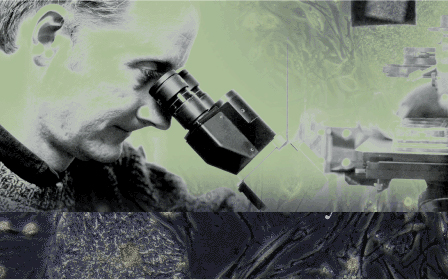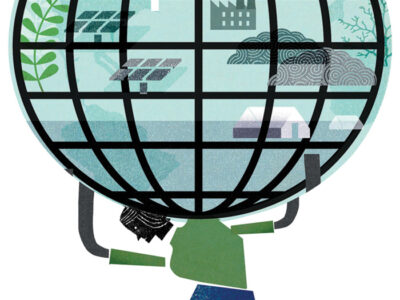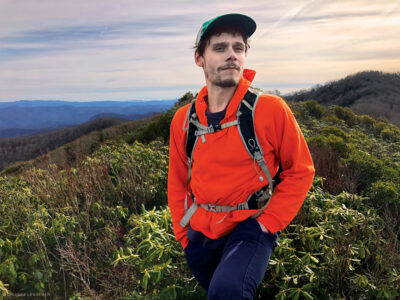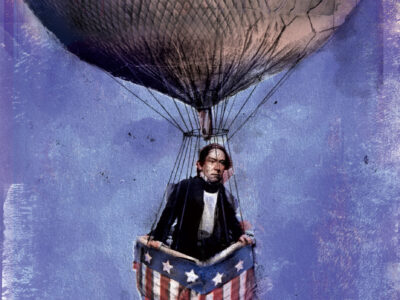
In 1998, graduate alumnus Dr. James Thomson won the race to isolate and culture human stem-cells for a sustained period—one of the holy grails of medical science—but he can’t outrun the controversy generated by his work. Increasingly, he isn’t trying.
By Leslie Whitaker
Developmental biologist Dr. James Thomson V’85 Gr’88 doesn’t like to waste time. He keeps his wardrobe basic, his speech succinct. (“The people I admire use relatively few words and choose them carefully,” he says.) Because he doesn’t think much of television, and he doesn’t want his children to squander the precious hours of their childhood, he doesn’t own a set.
So it’s not surprising that in his laboratory at the University of Wisconsin-Madison, where Thomson is assistant professor of anatomy in the Medical School and chief pathologist at the Wisconsin Regional Primate Research Center, he has cut to the heart of the matter. Ever since earning joint doctoral degrees in veterinary science and molecular biology at Penn, he has focused on stem cells, the most potent of nature’s basic building blocks. With the ability to develop into any one of the 220 cell types that make up the body, stem cells hold extraordinary promise for treating a host of debilitating illnesses, including diabetes, leukemia, Parkinson’s disease, heart disease, and spinal cord injury. Eventually, cultured stem cells may serve as a source of new healthy cells to replace damaged neurons, heart muscles, and brain tissue and to quickly test new wonder drugs. They may even help scientists solve a fundamental puzzle: why some cells stay healthy while others perish.
Stem cells themselves don’t waste much time. They emerge as an inner layer of the cluster of cells that form five or six days into the embryo’s development. Within another day or two they start to differentiate, transforming themselves into the specific cells they will become as the embryo grows into an entire body. Because many diseases can be traced to the malfunctioning of just a few specific cells, figuring out how to culture stem cells in a petri dish and then coax them into specific types of healthy cells on command has become one of the holy grails of medical science.
Along with that extraordinary promise, has come the complication of political controversy. While adult and animal cells are also being used to explore stem cell development, research on stem cells from human embryos is expected to be among the most fruitful. But that line of inquiry has been denounced by anti-abortion activists and conservative religious leaders, including Pope John Paul II, as immoral. Although the Clinton administration approved of funding for such work, since 1995 Congress had included language in its appropriation bill banning stem-cell research from receiving federal financing.
The federal coffers were pried open last August, however, by President George W. Bush, who surprised critics and supporters alike when he lifted the ban he had imposed—reversing the Clinton administration—upon taking office. Bush had apparently been swayed to reconsider after several prominent Republicans, including Senator Orrin Hatch and former First Lady Nancy Reagan spoke out forcefully in its favor, citing the potential for medical breakthroughs. Among those Bush consulted were Health and Human Services Secretary Tommy Thompson, who as governor of Wisconsin had praised James Thomson’s work.
But there was a catch: Bush banned research that used newly-created cell lines from receiving federal funding. To qualify for funding, researchers must restrict their work to stem cell lines that have already been created in accordance with NIH guidelines. While Thomson doubted the President’s assertion that there were 64 cell lines in existence that could be used by researchers, the scientist’s reaction to Bush’s announcement was characteristically composed: “I’m not completely happy with the decision,” he said, “but the President came a long way.”
The Discovery of a Lifetime
In past years, the reserved Thomson had been so reluctant to get caught up in the controversy that he knew would surely attend scientific discoveries in this area that for a time he seriously considered leaving the work to others. Ultimately he decided that its potential outweighed any other concerns. “I just decided it would be important enough to do it,” he says.
By 1998, Thomson was in the spotlight. Announcing what his peers have called “the discovery of a lifetime,” Thomson and his research team reported in Science that they were able to isolate and grow embryonic stem cells in a way that maintained their pluripotency—the ability to transform themselves into any kind of human cell. Using embryos that had been discarded by couples who sought in vitro fertilization at a University of Wisconsin clinic, Thomas generated five human embryonic stem cell lines derived from blastocysts, a hollow ball of about 150 cells that develops a few days after fertilization. He maintained the cells for five months before reporting his findings and grabbing the grail.
The landmark discovery was heralded as the biggest breakthrough since the cloning of Dolly the sheep in 1997. David Prentice, professor of life sciences at Indiana State University declared, “We are at the beginning of a revolution that will transform society, comparable to the Industrial Revolution—the biotechnology revolution. This time we will not be engineering machines, but engineering ourselves.” Dr. Austin Smith, director of Genome Research in Edinburgh, predicted that some day every individual would have sample tissue taken to establish a stem cell culture that can be frozen for use throughout their life. “If they have any kind of illness or injury, their own cells will be there, to be grown up and produce the particular kind of cells to treat their disease,” he said. Even Jamie, as his friends and colleagues call Thomson, was uncharacteristically effusive. The possibilities are “limitless,” he told reporters. “Our stem cells can give rise to everything, and they never die.”
Duplicate Labs
Thomson also expressed satisfaction last fall when the National Institutes of Health issued the regulations that would allow researchers to submit requests for federal funding just weeks after Bush’s announcement. “It could have been months and months” before they were issued, he says.
By his count, the Congressional ban on federal funding had already cost Thomson about a year. That’s because conducting research on human embryos in Madison without jeopardizing the entire university’s federal funding required him to set up a laboratory that replicated the one he already had at the Primate Center, where he had isolated stem cells from monkeys three years earlier. Thomson’s lab at the WiCell Research Institute, where he is scientific director, was set up specifically for stem-cell research and is operated by the Wisconsin Alumni Research Foundation (WARF), a not-for-profit entity that has managed patents on behalf of the University of Wisconsin since 1925. While the Primate Center laboratory operates in a pink-stucco building on campus, the lab dedicated to human stem cells is housed in an undisclosed location. Security concerns has made it strictly off-limits to visitors, including reporters.
Thomson’s work on human embryos has been funded in part by the Geron Corporation, a Menlo Park, California-based biotechnology firm, in exchange for some commercial rights. Thomson claims no financial connection to the company, but he does get a small percentage of the revenues generated by WARF, which holds the patents based on the methods described in the Science article.
Last August the relationship between WARF and Geron hit a snag, however. WARF, which holds patents based on the methods described in the Science article, sued Geron for asserting that it had exclusive rights to research products and services. Calling such an assertion contrary to their contract with the company and NIH guidelines, WARF asserted its own right to sell and distribute the stem cells to researchers. “We hope that federal funding and access to stem-cell research products will increase the number of researchers who work with human embryonic stem cells,” said Carl Gulbrandsen, WARF’s managing director. “A greater number of good researchers promise to bring the medicine of tomorrow closer to today.”
As of September, more than 100 academic researchers and numerous companies had approached WARF about licensing stem cell technology. WiCell supplies embryonic stem cells from both rhesus monkey (cost: $2,500) and human origin ($5,000). Scientists are required to sign a licensing agreement that prohibits them from using the cells for cloning or intermingling with intact embryos.
Despite the controversies and media attention, Thomson continues to maintain his focus. WARF administrators have handled the dispute with Geron. Thomson limits the times he spends with the media by screening his calls. When asked about his reaction to making the cover of Time last June because his work was the most “astonishing” of the 25 leaders in science and medicine profiled in that issue, he will only quip, “I was not looking forward to doing the grocery shopping that week.”
Eager Ethicist
While the ethical issues attending stem cell research only recently transfixed the rest of the world, Thomson has been considering them for years. After doing post-doctoral work in Oregon, Thomson moved to Wisconsin as a pathology resident and immediately began working at the Primate Lab. He preferred studying monkeys to mice, because even though they are more difficult to study they are better proxies for humans, especially when testing medical applications. “I was interested in primate development because it’s so similar to human development,” he explains.
Studying primates raised ethical concerns among animal rights advocates, but Thomson found a receptive audience in 1995 when his group reported the first generation of a primate embryonic stem cell line. Generated from a blastocyst of a rhesus monkey, it displayed all of the characteristics of a typical embryonic stem cell line. “We derived cell lines that allowed us to do tissue experiments that would actually reduce the need to do primate work,” he notes. The following year Thomson generated stem cell lines from the marmoset, small monkeys native to South America.
Because he knew isolating primate stem cells established the possibility that human embryonic stem cell lines could be derived, Thomson began to explore the ethical concerns of working with human embryos. Among those he consulted early on were University of
Wisconsin bioethicists Norman Fost and R. Alta Charo. “He invited me to his lab at the Primate Center and sat me down for a slide show explaining his work. Then he asked a series of questions,” recalls Charo, a University of Wisconsin law professor who served on the NIH human embryo panel. “He was very concerned about government rules and the general thinking, even if the government hadn’t caught up with the latest science. He seemed very open-minded. And I was very much impressed with the seriousness with which he took the inquiry.”
Fost agrees that Thomson was “very unusual” in his determination to carefully consider ethical issues before he embarked on his work. “He’s at the 99th percentile in that he paid very careful attention to ethical issues in hopes of attracting the widest possible support.” Even though he was receiving no federal funding, Thomson adjusted his protocols to be harmonious with NIH guidelines and reflect the consensus of opinion about how the research should be conducted.
Fost also has came to admire Thomson’s terseness. “He’s completely candid, nothing is concealed,” Fost says. “He speaks very clearly, and then shuts up.”
Thomson ultimately concluded that, if he restricted his work to embryos that would have been discarded by fertility clinics with the written and informed consent of couples who were undergoing treatment for infertility, he was on sound ethical ground. “It was difficult for me to imagine that discarding these embryos was a better ethical choice than using them for something that could help quite a lot of human beings,” he says.
Elementary Influences
Thomson’s interest in science was sparked early. He has cited two childhood influences—Ms. Joanne Schwichtenberg, his fourth grade teacher, and an uncle who worked at NASA. When his teacher reported excitedly on a talk she’d seen by Buckminster Fuller. “She spent half a day drawing diagrams [of Geodesic domes],” he says. “I remember that distinctly.” Thomson also vividly recalls his uncle taking him aside during a tour of NASA and whispering excitedly, “Can you believe they pay me for this?”
Thomson’s academic prowess has been honored since his high school days in suburban Chicago, when he was a National Merit Scholar and won the Illinois General Assembly Award. He was one of 25 or so teenagers selected from 2,000 applicants for the University of Illinois at Urbana-Champaign’s honors biology program, where undergraduates were handed keys to their own private labs.
Two papers he read as an undergraduate hooked Thomson on the early stages of development. One was a paper by Dr. Beatrice Mintz of the Fox Chase Cancer Center in Philadelphia. She put together the embryo of a white mouse and a black mouse and they self-rearranged to create one black-and-white mouse. “It was amazing to me that embryos could self-regulate that well,” Thomson says. “You end up taking what should be two individuals and making one. When I first heard about that experiment, I remember thinking that was really neat, and I started thinking about going into the field.”
The other was a paper published in 1974 by Dr. Ralph Brinster V’60 Gr’64, the Richard King Mellon Professor of Reproductive Physiology at Penn, who was then director of the joint VMD-PhD Combined Degree Program. In that paper, Brinster described an experiment in which teratocarcinoma cells that arise from male germ cells were put into the blastocyst, an early embryo stage, and the cancer cells were redirected to become part of the adult mouse. Thomson decided that he wanted to study with Brinster, and with good reason. Now the principal scientist at the vet school’s Center for Animal Transgenesis and Germ Cell Research, Brinster was already a major figure in the field of germ-line modification. (His latest breakthrough came last fall, when he announced that he had successfully used a retrovirus to modify genes in a mouse’s spermatogonial stem cells—the first instance of a transgenic animal created by inserting a gene into male germ-line stem cells. The experiment, Brinster said, proved that once the foreign genes have been inserted, they “will continue to be transmitted and expressed from one generation to the next.”)
The highly selective joint-degree program at Penn has produced only 47 graduates (including Thomson’s wife) since its establishment in 1969. “We only took two or three candidates a year,” Brinster notes. “They had to have strong grades and test scores and demonstrate an interest in research and practice. He already had some background in research so he was a very strong candidate.”
Last year Brinster shared the spotlight with his promising student when they both won awards from the University of Texas M.D. Anderson Cancer Center, presented during its annual Symposium on Fundamental Cancer Research. Brinster won the Ernst W. Bertner Memorial Award for a 40-year-career accentuated by “spectacular, resourceful, and highly innovative contributions to basic and applied research and to veterinary medicine.” Thomson won the Wilson S. Stone Memorial Award, created to recognize young researchers who have made outstanding contributions to biomedical sciences in the U.S., for his pioneering work in nonhuman primate and human embryonic stem cells.
Thomson learned how to derive embryonic stem cells from mice during his graduate years at Penn, one of the first schools to pursue their isolation. The University was also where he decided to focus on early mammalian development. Thomson’s Ph.D. advisor at Penn was Dr. Davor Solter, who was then at the Wistar Institute. “He was an ideal graduate student,” says Solter, who now works in the department of developmental biology at the Max-Planck Institute of Immunobiology in Freiburg, Germany. “Every few months he would ask if I had some time and then come in with a piece of paper listing what he had done and what he is going to do in the next three to six months. We would discuss it a little, but not much was needed, and then he would go and do it.”
While at Penn, Thomson also pursued his interest in aeronautics—alarming his teachers. “During our lab outings he was trying to master boomerangs,” Solter recalls, “and I was never sure we would survive it.”
A rotation during his senior year at veterinary school sent Thomson to the San Diego Zoo. Attracted by the cliffs over the Pacific, he learned how to hang-glide, a pastime he continued to pursue in Philadelphia, where he bought a glider. “There were either 50-100 foot hills or a 2,000 foot cliff, nothing in-between,” he complains, adding that he stuck to the foothills. In Wisconsin, however, Thomson has found more suitable terrain, and tries to pursue his hobby once a week in the summer.
Future Directions
Even when he is not aloft, Thomson is focusing on the big picture these days. Rather than work in the lab, he now spends much of his time directing his research team and writing grants. “I am enjoying thinking about things and deciding about the future direction of the work,” he says.
Thomson’s team, which includes numerous collaborators, is currently trying to coax the cultured stem cells into morphing into four distinct types of human cells: blood, heart, and pancreas cells, and neurons. Thomson also has decided to attempt to grow the first human embryonic stem cells free of the risk of carrying animal germs. If he were successful, those cells would likely become the ones used in human tests. Currently stem cells are cultured in animal feeder layers, cells from mice embryos that encourage the human cells to divide and multiply. The problem is that the feeder layers may be vulnerable to zoonosis, contamination from a germ from the animal species.
As the latest debate—over how many viable stem cell lines actually exist that qualify for federal funds—rages on, Thomson has his own estimate: “a dozen, at best.” But while he contends that this presents a “big problem for the future,” for now he is content to see that “the basic research gets going in a meaningful way.”
There is even some evidence that Thomson is getting a bit more comfortable with the spotlight. Professor Charo has observed that Thomson has emerged as an impressive advocate for his work. Recalling that the khaki pants and oxford-cloth shirt he wore to his first appearance before the Senate Appropriations Committee shortly after his landmark study was published shocked her, she doubts that he has yet to purchase a suit. “But over time, he has come to see part of his role as an educator,” she says, impressed by recent presentations to audiences as varied as politicians, entrepreneurs, students, and university regents.
Yet there has been absolutely no change in what Thomson finds most pressing. “He’s not interested in personal gain, but rather in advancing knowledge,” says Fost. “He’s the purest example of what you would want in a scientist.”
Leslie Whitaker, a regular Gazette contributor, is the co-author of The Good Girl’s Guide to Negotiating: How to Get What You Want at the Bargaining Table, which will be out in paperback in March from Little, Brown.




